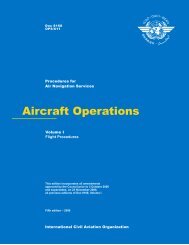Operation of Aircraft
Annex 6, Part I
Annex 6, Part I
- No tags were found...
Create successful ePaper yourself
Turn your PDF publications into a flip-book with our unique Google optimized e-Paper software.
Annex 6 — <strong>Operation</strong> <strong>of</strong> <strong>Aircraft</strong><br />
Part I<br />
2.4 Power failure point<br />
2.4.1 The power failure point is the point at which sudden<br />
complete loss <strong>of</strong> power from the power-unit, critical from the<br />
performance aspect in the case considered, is assumed to<br />
occur. If the airspeed corresponding to this point is less than<br />
the take-<strong>of</strong>f safety speed, it is demonstrated that, in the event<br />
<strong>of</strong> sudden failure <strong>of</strong> the critical power-unit at all speeds down<br />
to the lowest speed corresponding with the power failure point,<br />
the aeroplane is controllable satisfactorily and that the take-<strong>of</strong>f<br />
can be continued safely, using normal piloting skill, without:<br />
a) reducing the thrust <strong>of</strong> the remaining power-units; and<br />
b) encountering characteristics which would result in<br />
unsatisfactory controllability on wet runways.<br />
2.4.2 If the critical power-unit varies with the configuration,<br />
and this variation has a substantial effect on performance,<br />
either the critical power-unit is considered separately for<br />
each element concerned, or it is shown that the established<br />
performance provides for each possibility <strong>of</strong> single power-unit<br />
failure.<br />
2.4.3 The power failure point is selected for each take-<strong>of</strong>f<br />
distance required and take-<strong>of</strong>f run required, and for each<br />
accelerate-stop distance required. The pilot is provided with a<br />
ready and reliable means <strong>of</strong> determining when the applicable<br />
power failure point has been reached.<br />
2.5 Accelerate-stop distance required<br />
2.5.1 The accelerate-stop distance required is the distance<br />
required to reach the power failure point from a standing start<br />
and, assuming the critical power-unit to fail suddenly at this<br />
point, to stop if a landplane, or to bring the aeroplane to a<br />
speed <strong>of</strong> approximately 9 km/h (5 kt) if a seaplane.<br />
2.5.2 Use <strong>of</strong> braking means in addition to, or in lieu <strong>of</strong>,<br />
wheel brakes is permitted in determining this distance,<br />
provided that they are reliable and that the manner <strong>of</strong> their<br />
employment is such that consistent results can be expected<br />
under normal conditions <strong>of</strong> operation, and provided that<br />
exceptional skill is not required to control the aeroplane.<br />
2.6 Take-<strong>of</strong>f run required<br />
The take-<strong>of</strong>f run required is the greater <strong>of</strong> the following:<br />
1.15 times the distance required with all power-units<br />
operating to accelerate from a standing start to take<strong>of</strong>f<br />
safety speed;<br />
2.7 Take-<strong>of</strong>f distance required<br />
2.7.1 The take-<strong>of</strong>f distance required is the distance<br />
required to reach a height <strong>of</strong>:<br />
10.7 m (35 ft), for aeroplanes with two power-units,<br />
15.2 m (50 ft), for aeroplanes with four power-units,<br />
above the take-<strong>of</strong>f surface, with the critical power-unit failing<br />
at the power failure point.<br />
2.7.2 The heights mentioned above are those which can<br />
be just cleared by the aeroplane when following the relevant<br />
flight path in an unbanked attitude with the landing gear<br />
extended.<br />
Note.— Paragraph 2.8 and the corresponding operating<br />
requirements, by defining the point at which the net take-<strong>of</strong>f<br />
flight path starts as the 10.7 m (35 ft) height point, ensure that<br />
the appropriate net clearances are achieved.<br />
2.8 Net take-<strong>of</strong>f flight path<br />
2.8.1 The net take-<strong>of</strong>f flight path is the one-power-unitinoperative<br />
flight path which starts at a height <strong>of</strong> 10.7 m (35 ft)<br />
at the end <strong>of</strong> the take-<strong>of</strong>f distance required and extends to a<br />
height <strong>of</strong> at least 450 m (1 500 ft) calculated in accordance<br />
with the conditions <strong>of</strong> 2.9, the expected gradient <strong>of</strong> climb<br />
being diminished at each point by a gradient equal to:<br />
0.5 per cent, for aeroplanes with two power-units,<br />
0.8 per cent, for aeroplanes with four power-units.<br />
2.8.2 The expected performance with which the aeroplane<br />
is credited in the take-<strong>of</strong>f wing flap, take-<strong>of</strong>f power condition,<br />
is available at the selected take-<strong>of</strong>f safety speed and is<br />
substantially available at 9 km/h (5 kt) below this speed.<br />
2.8.3 In addition the effect <strong>of</strong> significant turns is<br />
scheduled as follows:<br />
Radius. The radius <strong>of</strong> a steady Rate 1 (180 degrees per<br />
minute) turn in still air at the various true airspeeds<br />
corresponding to the take-<strong>of</strong>f safety speeds for each wing-flap<br />
setting used in establishing the net take-<strong>of</strong>f flight path below<br />
the 450 m (1 500 ft) height point, is scheduled.<br />
Performance change. The approximate reduction in<br />
performance due to the above turns is scheduled and<br />
corresponds to a change in gradient <strong>of</strong><br />
1.0 times the distance required to accelerate from a<br />
standing start to take-<strong>of</strong>f safety speed assuming the<br />
critical power-unit to fail at the power failure point.<br />
1/11/01 ATT C-14<br />
V<br />
0.5⎛ ⎞ 2<br />
⎝185.2⎠<br />
% where V is the true airspeed<br />
in km/h; and












